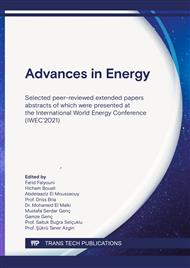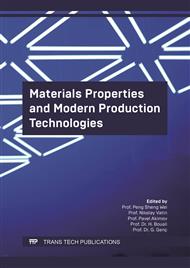[1]
Q.H. Wang, K. Kalantar-Zadeh, A. Kis, J.N. Coleman, M.S. Strano, Electronics and optoelectronics of two-dimensional transition metal dichalcogenides, Nat. Nanotechnol. 7 (2012) 699–712. https://doi.org/10.1038/nnano.2012.193.
DOI: 10.1038/nnano.2012.193
Google Scholar
[2]
D. Jiménez, Drift-diffusion model for single layer transition metal dichalcogenide field-effect transistors, Appl. Phys. Lett. 101 (2012) 243501. https://doi.org/10.1063/1.4770313.
DOI: 10.1063/1.4770313
Google Scholar
[3]
C. Gong, Y. Zhang, W. Chen, J. Chu, T. Lei, J. Pu, L. Dai, C. Wu, Y. Cheng, T. Zhai, L. Li, J. Xiong, Electronic and Optoelectronic Applications Based on 2D Novel Anisotropic Transition Metal Dichalcogenides, Adv. Sci. 4 (2017) 1700231. https://doi.org/10.1002/advs.201700231.
DOI: 10.1002/advs.201700231
Google Scholar
[4]
M.A. Khan, M.N. Leuenberger, Optoelectronics with single layer group-VIB transition metal dichalcogenides, Nanophotonics. 7 (2018) 1589–1600. https://doi.org/10.1515/nanoph-2018-0041.
DOI: 10.1515/nanoph-2018-0041
Google Scholar
[5]
M. Porer, U. Leierseder, J.-M. Ménard, H. Dachraoui, L. Mouchliadis, I.E. Perakis, U. Heinzmann, J. Demsar, K. Rossnagel, R. Huber, Non-thermal separation of electronic and structural orders in a persisting charge density wave, Nat. Mater. 13 (2014) 857–861. https://doi.org/10.1038/nmat4042.
DOI: 10.1038/nmat4042
Google Scholar
[6]
Y. Ma, Y. Dai, M. Guo, C. Niu, Y. Zhu, B. Huang, Evidence of the Existence of Magnetism in Pristine VX 2 Monolayers (X = S, Se) and Their Strain-Induced Tunable Magnetic Properties, ACS Nano. 6 (2012) 1695–1701. https://doi.org/10.1021/nn204667z.
DOI: 10.1021/nn204667z
Google Scholar
[7]
C.-X. Liu, Unconventional Superconductivity in Bilayer Transition Metal Dichalcogenides, Phys. Rev. Lett. 118 (2017) 087001. https://doi.org/10.1103/PhysRevLett.118.087001.
DOI: 10.1103/physrevlett.118.087001
Google Scholar
[8]
R.G. Dickinson, L. Pauling, THE CRYSTAL STRUCTURE OF MOLYBDENITE, J. Am. Chem. Soc. 45 (1923) 1466–1471. https://doi.org/10.1021/ja01659a020.
DOI: 10.1021/ja01659a020
Google Scholar
[9]
J.A. Wilson, A.D. Yoffe, The transition metal dichalcogenides discussion and interpretation of the observed optical, electrical and structural properties, Adv. Phys. 18 (1969) 193–335. https://doi.org/10.1080/00018736900101307.
DOI: 10.1080/00018736900101307
Google Scholar
[10]
P.A. Lee, G. Said, R. Davis, T.H. Lim, ON THE OPTICAL PROPERTIES OF SOME LAYER COMPOUNDS, (n.d.) 11.
Google Scholar
[11]
I. Kar, J. Chatterjee, L. Harnagea, Y. Kushnirenko, A.V. Fedorov, D. Shrivastava, B. Büchner, P. Mahadevan, S. Thirupathaiah, Metal-chalcogen bond-length induced electronic phase transition from semiconductor to topological semimetal in Zr X 2 ( X = Se and Te), Phys. Rev. B. 101 (2020) 165122. https://doi.org/10.1103/PhysRevB.101.165122.
DOI: 10.1103/physrevb.101.165122
Google Scholar
[12]
T.M. Herninda, C.-H. Ho, Optical and Thermoelectric Properties of Surface-Oxidation Sensitive Layered Zirconium Dichalcogenides ZrS2−xSex (x = 0, 1, 2) Crystals Grown by Chemical Vapor Transport, Crystals. 10 (2020) 327. https://doi.org/10.3390/cryst10040327.
DOI: 10.3390/cryst10040327
Google Scholar
[13]
W.Y. Liang, S.L. Cundy, Electron energy loss studies of the transition metal dichalcogenides, Philos. Mag. 19 (1969) 1031–1043. https://doi.org/10.1080/14786436908225867.
DOI: 10.1080/14786436908225867
Google Scholar
[14]
H.P. Hughes, W.Y. Liang, Vacuum ultraviolet reflectivity spectra of the disulphides and diselenides of titanium, zirconium and hafnium, J. Phys. C Solid State Phys. 10 (1977) 1079–1087. https://doi.org/10.1088/0022-3719/10/7/018.
DOI: 10.1088/0022-3719/10/7/018
Google Scholar
[15]
S.C. Bayliss, W.Y. Liang, Reflectivity, joint density of states and band structure of group IVb transition-metal dichalcogenides, J. Phys. C Solid State Phys. 18 (1985) 3327–3335. https://doi.org/10.1088/0022-3719/18/17/010.
DOI: 10.1088/0022-3719/18/17/010
Google Scholar
[16]
A. Singh, Y. Li, B. Fodor, L. Makai, J. Zhou, H. Xu, A. Akey, J. Li, R. Jaramillo, Near-infrared optical properties and proposed phase-change usefulness of transition metal disulfides, Appl. Phys. Lett. 115 (2019) 161902. https://doi.org/10.1063/1.5124224.
DOI: 10.1063/1.5124224
Google Scholar
[17]
H. Jiang, Structural and electronic properties of ZrX 2 and HfX 2 (X = S and Se) from first principles calculations, J. Chem. Phys. 134 (2011) 204705. https://doi.org/10.1063/1.3594205.
DOI: 10.1063/1.3594205
Google Scholar
[18]
A. Afzal, R.S. Islam, S.H. Naqib, Structural, elastic, bonding, optoelectronic, and some thermo- physical properties of transition metal dichalcogenides ZrX2 (X = S, Se, Te): Insights from ab-initio calculations, (n.d.) 31.
DOI: 10.1063/5.0073631
Google Scholar
[19]
A.H. Reshak, S. Auluck, Theoretical investigation of the electronic and optical properties of ZrX2 (X=S, Se and Te), Phys. B Condens. Matter. 353 (2004) 230–237. https://doi.org/10.1016/j.physb.2004.10.001.
DOI: 10.1016/j.physb.2004.10.001
Google Scholar
[20]
H. Isomaki, J. von Boehm, P. Krusius, Band structure of group IVA transition-metal dichalcogenides, J. Phys. C Solid State Phys. 12 (1979) 3239–3252. https://doi.org/10.1088/0022-3719/12/16/012.
DOI: 10.1088/0022-3719/12/16/012
Google Scholar
[21]
S.J. Clark, M.D. Segall, C.J. Pickard, P.J. Hasnip, M.I.J. Probert, K. Refson, M.C. Payne, First principles methods using CASTEP, Z. Für Krist. - Cryst. Mater. 220 (2005) 567–570. https://doi.org/10.1524/zkri.220.5.567.65075.
DOI: 10.1524/zkri.220.5.567.65075
Google Scholar
[22]
B.G. Pfrommer, M. Côté, S.G. Louie, M.L. Cohen, Relaxation of Crystals with the Quasi-Newton Method, J. Comput. Phys. 131 (1997) 233–240. https://doi.org/10.1006/jcph.1996.5612.
DOI: 10.1006/jcph.1996.5612
Google Scholar
[23]
R.H. Friend, A.D. Yoffe, Electronic properties of intercalation complexes of the transition metal dichalcogenides, Adv. Phys. 36 (1987) 1–94. https://doi.org/10.1080/00018738700101951.
DOI: 10.1080/00018738700101951
Google Scholar
[24]
W. Conroy, K.C. Park, Electrical Properties of the Group IV Disulfides Tis,, ZrS,, HfS,, and SnS,1,2, (1968) 5.
Google Scholar
[25]
R.B. Murray, R.A. Bromley, A.D. Yoffe, The band structures of some transition metal dichalcogenides. II. Group IVA; octahedral coordination, J. Phys. C Solid State Phys. 5 (1972) 746–758. https://doi.org/10.1088/0022-3719/5/7/006.
DOI: 10.1088/0022-3719/5/7/006
Google Scholar
[26]
R.L. Olmon, B. Slovick, T.W. Johnson, D. Shelton, S.-H. Oh, G.D. Boreman, M.B. Raschke, Optical dielectric function of gold, Phys. Rev. B. 86 (2012) 235147. https://doi.org/10.1103/PhysRevB.86.235147.
DOI: 10.1103/physrevb.86.235147
Google Scholar
[27]
F. Wooten, Optical Properties of Solids, (n.d.) 270.
Google Scholar
[28]
T.V. Vu, A.A. Lavrentyev, D.V. Thuan, C.V. Nguyen, O.Y. Khyzhun, B.V. Gabrelian, K.C. Tran, H.L. Luong, P.D. Tung, K.D. Pham, P.T. Dang, D.D. Vo, Electronic properties and optical behaviors of bulk and monolayer ZrS2: A theoretical investigation, Superlattices Microstruct. 125 (2019) 205–213. https://doi.org/10.1016/j.spmi.2018.11.008.
DOI: 10.1016/j.spmi.2018.11.008
Google Scholar
[29]
Vitesse supraluminique - Définition et Explications, (n.d.). https://www.techno-science.net/ glossaire-definition/Vitesse-supraluminique.html (accessed December 13, 2021).
Google Scholar
[30]
R. Saniz, L.-H. Ye, T. Shishidou, A.J. Freeman, Structural, electronic, and optical properties of NiAl 3 : First-principles calculations, Phys. Rev. B. 74 (2006) 014209. https://doi.org/10.1103/PhysRevB.74.014209.
DOI: 10.1103/physrevb.74.014209
Google Scholar



